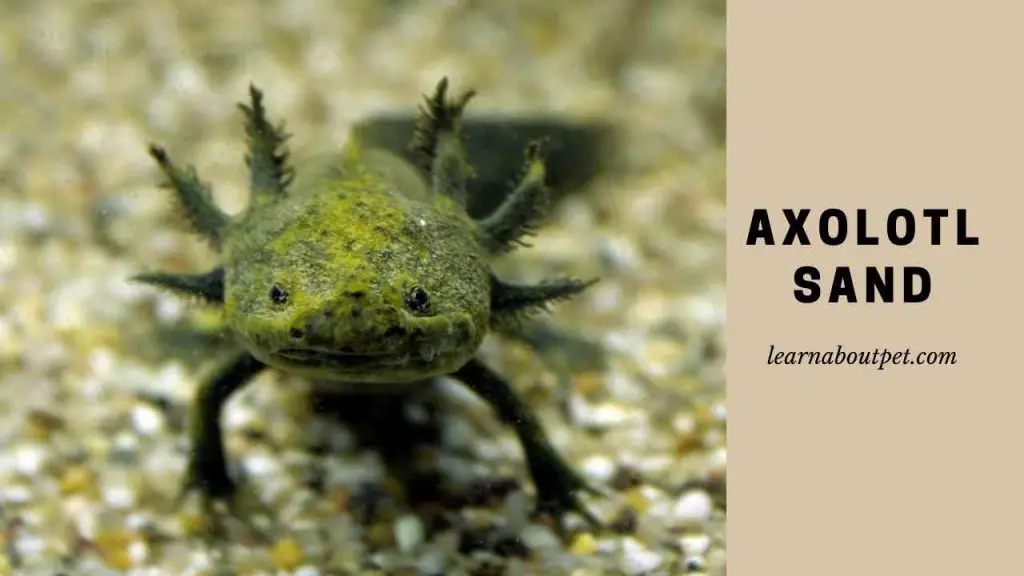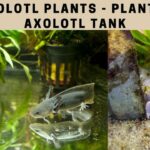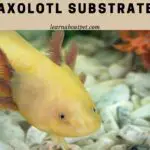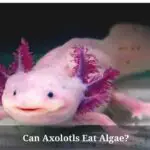As an axolotl owner, you may find yourself considering using sand as a substrate in your axolotl’s tank. This would lead to interesting questions – like whether sand is suitable for use in an axolotl tank, and if yes, what type of sand to use and how to go about using it. This article answers all these questions.
Sand is suitable for use as a substrate in an axolotl’s tank. Axolotl sand can promote growth of useful plants and beneficial bacteria in the tank. It also provides something for the axolotl’s feet to grip on as it moves at the bottom of the tank. And it gives your axolotl tank a more natural feel.
The most important thing is to ensure that the sand you use is very fine and smooth. You may also need to sieve the sand, so that there are no foreign objects in it before putting it in the axolotl tank.

And you may need to sanitize the sand, by boiling it for instance, before putting it in the axolotl’s tank.
Can You Put Sand In Axolotl Tank?
To put it differently, is sand in the bottom of an axolotl tank okay?
The simple answer is ‘yes’. Axolotl sand substrate can work quite well. It is better than having a bare bottom axolotl tank.
The axolotl sand substrate serves at least three purposes. Firstly, it promotes growth of useful plants in the axolotl tank. It also promotes the proliferation of useful bacteria in the axolotl tank.
Secondly, the sand gives an ideal surface for the axolotl to move on, when it is at the bottom of the tank.
And thirdly, the sand gives the axolotl tank a natural feel. It helps in mimicking the axolotl’s natural habitat in Mexico’s shallow lakes and canals, which are sandy.
But not just any type of sand is suitable for use in an axolotl tank. The sand that you use in the axolotl tank should be fine and smooth.
You have to understand that when it comes to an axolotl eating sand is quite a common thing. Now if the axolotl substrate sand in your tank is smooth, it should just go through the axie’s digestive system, and come out through the other end.
But if the axolotl sand size is big (that is, if the sand is rough), there can be major problems when the axolotl eats it. It may end up causing grievous injury to the axolotl.
Therefore before putting any sand in axolotl tank, that is something you need to keep in mind.
What Kind Of Sand Do You Use For Axolotls?
The most important thing is to ensure that the sand you use is fine and smooth. This way, even if the axolotl eats it, he won’t end up incurring injuries. Therefore safety is the key consideration here.
One kind of axolotl safe sand is the so-called aquarium sand. Axolotl aquarium sand works well because it tends to be quite smooth and fine: hence largely harmless even if the axolotl eats it.
Another type of suitable axolotl tank sand is what we refer to as play sand. This is also a suitable axolotl sand substrate on account of its smooth and fine nature.
Conversely, the likes of axolotl silica sand may be unsuitable, due to big granular size. Axolotl sand impaction can be very severe, if the axie happens to ingest this type of sand.
Besides the smoothness/fineness consideration, there is also the toxins consideration. The best axolotl sand needs to be free of toxins. Therefore dyed sand is out of question here.
For instance, because of the presence of dyes (which can be toxic), you find that black axolotl sand may not be suitable.
The axolotl black sand may otherwise be very fine and smooth. But due to the presence of dyes in it, there is potential for toxicity: hence its unsuitability.
Therefore that is really not an ideal axolotl sand type.
Another key thing is to avoid using sand that is likely to interfere with the tank’s PH. It is for this reason that most people would consider something like aragonite sand for axolotl tank unsuitable.
Can You Use Aquarium Sand For Axolotl Tank?
Yes, aquarium sand is suitable for use in axolotl tanks. In fact, it is arguably the best sand for axolotls tanks.
The most important thing is to ensure that you use just the right amount of it. After opting to be using it, you may also need to learn how to clean axolotl sand and how to change axolotl sand as need arises.
An example of aquarium sand that is ideal for use in an axolotl tank is Caribsea sand. Therefore, Caribsea sand for axolotl tank works quite well.
Can I Use The Sand From The Beach For My Axie’s Tank?
Beach sand may really not be the best axolotl sand. This is because the crushed (calcium) shells in it often cause it to be capable of raising the water’s PH too much.
Sometimes, you may also find that the beach sand granules are quite big: hence making it further less suitable.

Can You Use Play Sand For Axolotl Tank?
When looking for safe sand for substrate usage in an axolotl tank, you may find yourself considering play sand.
So is play sand suitable for this purpose? The answer is ‘yes’. Play sand tends to be fine and smooth enough for use in axolotl tank.
It can even be an effective baby axolotl sand, on account of its texture. (That is unless one belongs to the school of thought which is against the use of sand as substrate in baby and juvenile axolotl tanks).
So play sand is very good for use in axolotl tanks. That is of course unless it happens to have dye: which would make it potentially toxic to the axolotls.
Remember what we said with regard to the idea of using black sand for axolotls tanks? That is what comes into play here. So axolotl play sand is suitable: unless it happens to be dyed.
How To Put Sand In Axolotl Tank?
After acquiring sand that is fine and smooth enough (and which is also free of dyes and other potential toxins), you first need to clean it.
Then you may put the sand halfway in a bottle, and fill the other half of the bottle with water. This has to be dechlorinated water of course.
Thereafter, put the bottle with the water and sand into the aquarium, and let the water and sand flow into the tank naturally. The sand should then sink to the bottom of the tank.
Of course, once you have the sand in the tank, you will need to learn how to clean sand in axolotl tank properly. Then you need to be cleaning and changing the sand regularly.
What Are The Alternative To Sand For Axolotl Tank?
There are people who still have concerns/discomfort about the idea of using axolotl sand substrate.
While answering the is sand OK for axolotl tank question, we saw that it is largely OK. Yet there are people who still have concerns about the axolotl sand substrate idea.
But whereas they may be uncomfortable with the idea of using sand, one may also not be comfortable with the idea of having an axolotl bare bottom tank.
So that leads to the question on axolotl no sand options. One may frame the question as: what should I put in the bottom of my axolotl tank, other than sand?
Now what to put at the bottom of an axolotl tank (other than sand) is, for instance gravel. In fact, in axolotl lover forums, there is always a fierce axolotl sand or gravel substrate debate going on.
There are those who swear by sand. They may go as far as posting videos of an axolotl digging in sand: and then ask whether that would be possible with gravel substrate.
And there are those who believe that gravel is the better substrate.
Ultimately, gravel is suitable – as long as the pebbles are big enough not to be eatable by the axolotl.
There are even those who put sand at the bottom of their Axie tanks, then top it up with gravel.
Another axolotl sand substrate alternative is slate. So sand, gravel and slate are all suitable here.
Final Verdict – Axolotl Sand
Sand is suitable for us as substrate in an axolotl tank. The sand that one uses in an axolotl tank needs to be fine and smooth. That way, it would be comfortable for the axolotl, with its delicate legs, to walk on. And even if the axolotl happens to eat it, it would be more or less harmless.

Further, the sand should be of a type that doesn’t affect the tank water’s PH too much. And it shouldn’t have toxins, such as dyes.
Among the types of sand you can use in an axolotl tank are aquarium sand and play sand.
As a pet lover, make sure to learn about pet more and give your pet axolotl a good and comfortable life!

Welcome to Learn About Pet. My name is Rajkumar Ravichandran and I love all pets, travel, and amazing food. I write about my passion and personal experience caring for multiple pets in this blog! ❤️
Post Disclaimer
DISCLAIMER: THIS BLOG OR WEBSITE, "Learn About Pet", DOES NOT PROVIDE YOU WITH MEDICAL ADVICE AND IS NOT A SUBSTITUTE FOR MEDICAL ADVICE. ALWAYS GET IN TOUCH WITH YOUR PERSONAL VETERINARIAN AND USE INFORMATION HERE AS GENERAL ADVICE.
The information, including but not limited to, text, graphics, images and other material contained on this website are for informational purposes only. No material on this site is intended to be a substitute for professional veterinary advice, food recommendation, diagnosis, or treatment. Always seek the advice of your veterinarian or other qualified health care provider with any questions you may have regarding a medical condition or for pet food related questions.







